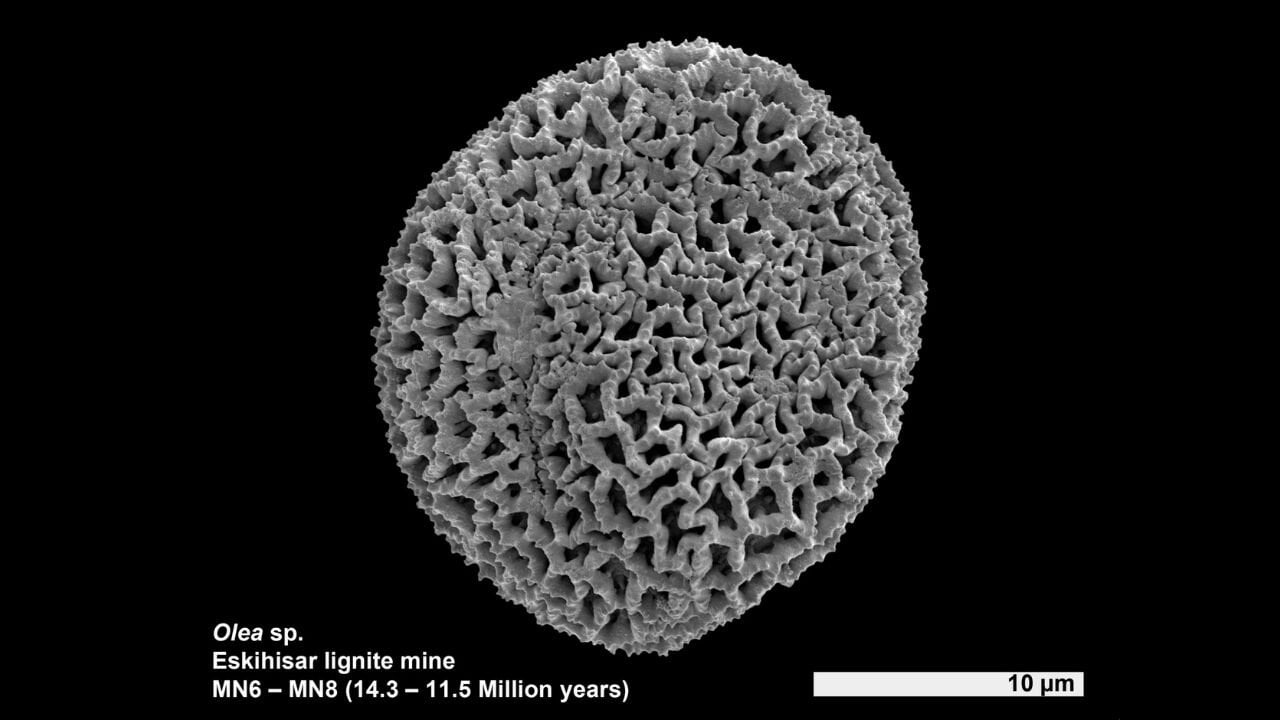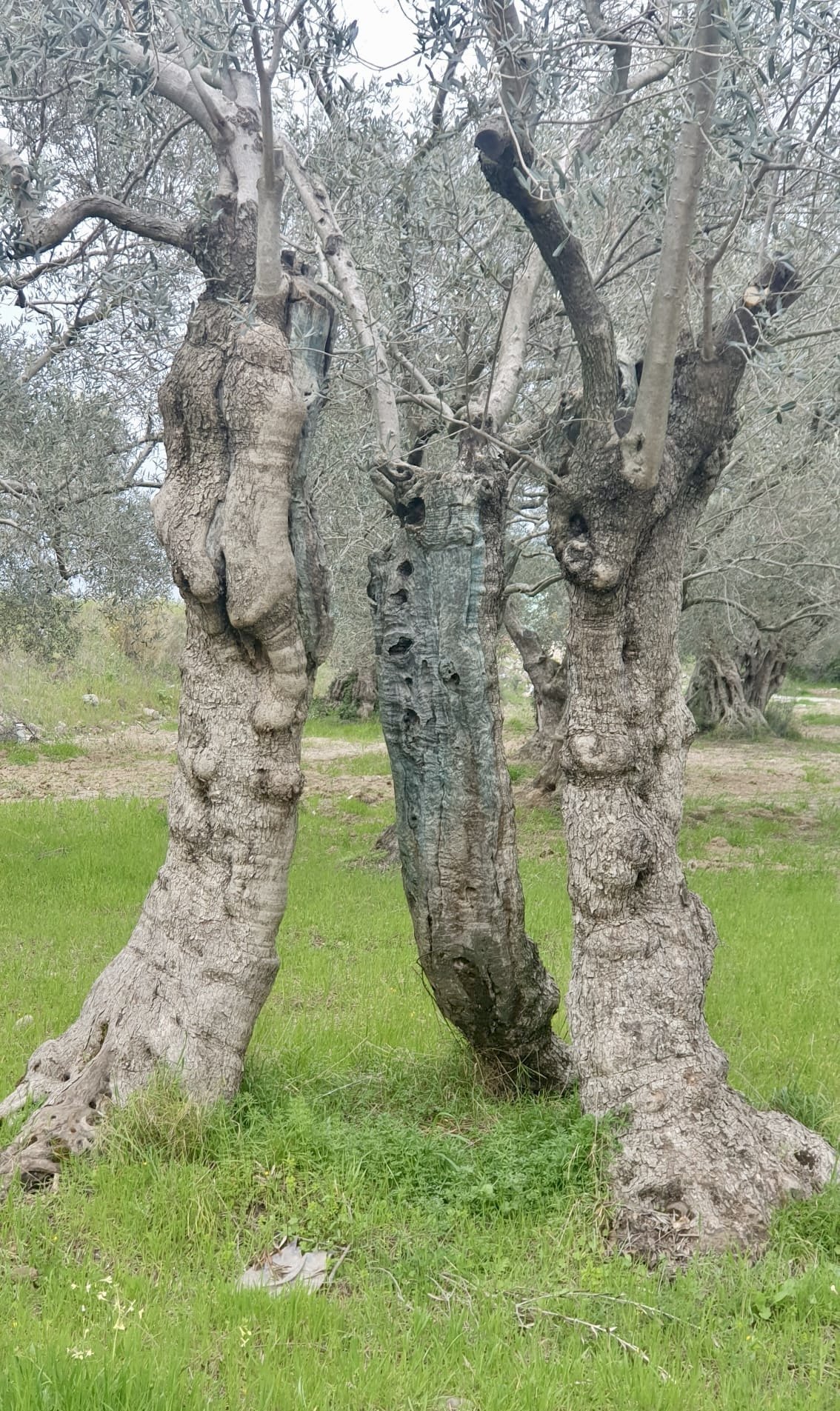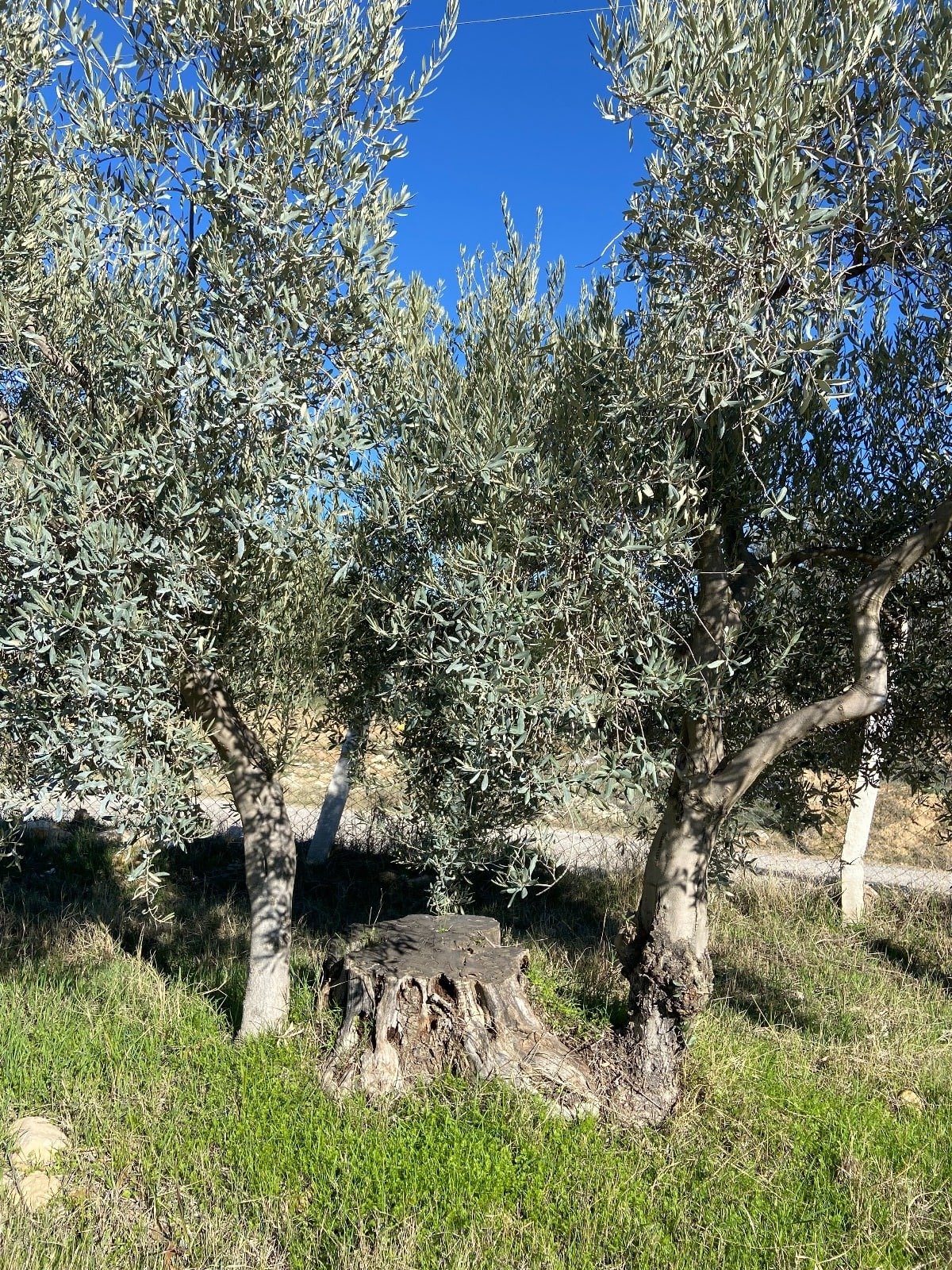Zeytin Ağacı

Etimolojik Köken
Zeytin kelimesinin dilbilimsel kökeni kesin olarak bilinmemekle beraber; Afro-Asya kökenli olan Sami dilindeki “zayit” kelimesinden türediği düşünülmektedir. Bu yargının nedeni zeytini ilk ıslah eden halkların Verimli Hilal bölgesinde yerleşik yaşam kültürünü başlatmış olan Sami kavimleri olduğu gerçeğidir.
Etimolojik açıdan, İbranice ’de “zait”, Arapça “ez-zeyt” ile “zaitun” ya da Anadolu’nun eski kavimlerinden Akadların kullandığı “zeirtim” sözcüklerinden türediği üzerinde fikirbirliği vardır. Mısır dilindeki “dt” (zeyt) sesinin kuzey batı Sami dilinden köken aldığı kanaati mevcuttur.
"Zeyyat" kelimesi Türkçede var olan arapça kökenli bir kelimedir, erkek ismidir, "zeytinyağı ve zeytinyağı üreten kimse" anlamında kullanılmış olmakla birlikte Arapça anlamının zeytinyağı ile ilişkisi yoktur, Arapça "bolluk, bereket, artış" anlamında kullanılır. Araplar yaşlı ve büyük ağaçlara, günümüzde bile, "zeitun er-Rum" derler.
Eski Girit’te “elaiwa”, Yunanca “elaia”, Latince “olea” dan gelir. Romalılar "oliva", Batı Avrupalı halklar ise "olive" demeyi tercih etmişlerdir.
Zeytinin ilk kez ıslah edildiği Verimli Hilal bölgesinin hemen batısında yükselen, Mersin ilindeki "Elaiussa Sebaste" isimli Doğu Akdeniz antik Roma liman kentinin adı Helenistik dönemde "Elaiussa" olarak biliniyordu. Elaiussa kelimesinin o devirlerdeki anlamı “zeytin”di. Sebaste ise klasik antik dönemde sıkça kullanılan bir yer ismi olup "Sebastus" isminin dişi halidir. Şehre dişilik vurgusu yapan bu isimlendirme, olasılıkla zeytini yaratan tanrıça olduğuna inanılan Athena kültü ile ilişkilidir.
Ağacın Temel Özellikleri
Olea europae L. sativa (kültür zeytini/tarımı yapılan zeytin) Olea europaea L. oleaster (yabani zeytin) isimli zeytinin ıslah edilmiş bir alt türüdür.
Anadolu'da yabani zeytine “Delice Zeytin” adı verilir, Ak Delice ve Kara Delice olmak üzere iki çeşidi mevcuttur, Ak Delice açık renkli ve iri yapraklı, Kara Delice ise küçük ve koyu renkli yapraklıdır. Ortalama dört metre boyda çalı görünümünde bir ağaçtır. Taneleri ufak, koyu yeşil renktedir, meyvesi yenebilecek özellikler taşımaz, yağ içeriği azdır. Ama gövdesi aşılama uygulaması için kullanılır. Ülkemizde delicelerin coğrafya olarak en fazla sayıda bulunduğu bölge, Ege Denizi kıyılarıdır. Tarihte, ilk evcilleştirildiği coğrafya olduğu düşünülen Doğu Akdeniz ve Güney Önasya'da (Yukarı Mezopatamya) bile bu kadar çok yabani zeytin ağacı olmaması iklim değişiklikleri ile ilgili olabilir. Doğada kendiliğinden varlığını sürdürüp yetişen deliceler sökülüp başka bir yere taşınabilmektedir. Gövdesine yapılan aşılama uygulaması (ana gövdeye ıslah edilmiş bir L. sativa türü zeytinden alınan dalın tarnsplante edilmesi) meyve verim süresini kısaltmak ve delicenin köklenme kapasitesinden faydalanmak için yapılır. Yabani zeytin doğada sığırcık ve karatavuk gibi bazı kuş türleri ile yayılır.
Olea europae L. sativa kuzey 30-45 paralelleri arasında, genellikle deniz kıyılarında yetişir, narindir, yavaş büyür. Yetiştirmesi emek ister fakat, oldukça uzun ömürlüdür. İyi ve doğru tarım uygulamaları ve düzenli budama ile yüzlerce yıl ürün verme kapasitesine sahiptir. Yaşı ilerledikçe heybetli ve estetik bir görünüme bürünür. Boyu 8-10 metreye ulaşabilir.
Ortalama ömrü 300-400 yıldır, verimli bir ömrün sonunda boşalan gövdesi kuruyarak köklerinden yeşeren sürgünler yeniden yeni bir ağaca dönüşebilir. Orman yangınlarında yanan alanda birkaç ay içinde yeniden yeşerir. Bitkinin toprak üstü kısımları yansa da toprak altı kısımları ölmemiştir. Ülkemizde 2010’ların ortasında Mersin’de, odun olarak kesilmek üzereyken kökleri olduğu fark edilen ve tekrar toprağa dikilen 800 yıllık zeytin ağacı, iki yaşındaki bir fidan ile aşılanıp yoğun bir besleme ve bakım süreci sonrasında meyve vermeye başlamıştır. Akdeniz Havzası'nda üç bin yaşında zeytin ağaçları mevcuttur, en ünlüsü Girit adasındadır, “antik zeytin ağacı/ata ağaç” olarak tanınır, üstelik hala zeytin de vermektedir. 3000 ila 3500 yıl yaşında olduğu gösterilen bu tür ağaçların bir kısmı ülkemizde Muğla ve çevresinde de mevcuttur.
Botanik açıdan yirmiye yakın zeytin türü mevcuttur, bu türler içerisinde Oleacea familyasına dâhil yağ üreten alt türlerin çoğunluğu ağaç, ağaççık ve çalı formunda olup çiçek ve meyvelerinde yüksek oranda yağ içerirler, tropik ve yarı-tropik iklim kuşağında yaygınlaşmışlardır. Ekonomik açıdan zeytin ve zeytinyağı tarımına en elverişli olanı Olea europae L. sativa’dır. Bu familyadaki yetiştiriciliği yapılan türler diğerlerine göre daha fazla yağ içerirler.
Kıyı bölgeleri dışında, yükseltilerinin az oluşu nedeniyle zeytinin yetişebilmesi için gerekli elverişli iklim şartlarına sahip iç kesimlerde de yaşar. Kurak topraklarda yetiştirilmeye elverişli olan zeytin ağacı için en verimli ortam yazları sıcak, kışları ise ılıman geçen iklimlerdir. Dona ve su ihtiyacının karşılanması şartıyla susuzluğa dayanıklı, -7 ila +40 C° arasındaki sıcaklılarda yaşayan, neredeyse 800 metre rakıma kadar varlığını sürdürebilen bir ağaçtır. Günümüzde İspanya’da 1200 metrede, Fas’ta Atlas Dağları’nda 1700 metrede ve Arjantin’de 2000 metre rakımda zeytinlikler bulunmaktadır. Güney yamaçları seven, 2 metreye kadar derinliği olan toprakla yetinen ve yaşamını sürdürebileceği toprak özellikleri açısından çok seçici olmayan bir ağaçtır.
Yıllık yağışın minimum 600 mm’yi bulduğu sahalarda sulanmaksızın yetiştirilebilir. Yıllık ortalama 220 mm yağış zeytin ağacının verimli bir şekilde büyümesi için yeterlidir. Mısırda Nil kenarında günde 14 saat yılda 10 ay damlama sulama yapılarak çöl toprağında zeytin yetiştirilebilmektedir. Yetişmesi için hafif kireçli, kumlu çakıllı ve killi toprak yeterlidir, “fakir toprakların zengin ağacı” diye anılır.
Yurdumuzda zeytinliklerin yaklaşık % 75'i eğimli, dağlık ve yamaç arazilerde yer almaktadır.
Genellikle 300-400 yıl yaşayan uzun ömürlü bir ağaçtır. Nadir de olsa doğada 2000 yılı geçen yaşa ulaşan xeytin ağaclarının varlığı, onun kuraklığa dirençli ve iklim değişimlerine adapte olabilen karakteri ile bağlantılıdır.
Fotoğraf; Zeytin Ağacı, Dr. Suat Çağlayan Arşivi.
Zeytin Ağacının Morfolojik Özellikleri
Gövde
Yapısı fonksiyonel yönden birbirinden bağımsız farklı bölümleri olan bir takıma benzer. Toprak düzeyinde ya da hemen altında gövdeden daha geniş, yumrular oluşturan bir gövdesi daha vardır, kökleri buradan çıkarak dallanır. Ağaç gövdesinin toprak altında kalan bu kısmına “turp”, bunun etrafındaki şişkinliklere “yumru” denir. Turp, ağacın yedek gıda deposudur. İhtiyaçtan fazla nem ve bitki besinlerini burada depo eder. Zeytin ağacının herhangi bir kısmı kök yapma özelliğine sahiptir. Ağaç belli bir yaşa eriştikten sonra şekillenen yumruların daha çok kök yapma özelliği vardır ve ağacın kendini yenileyebilme karakteri bu yumrular ile ilişkilidir. Boyu 8 metreye kadar ulaşabilir fakat hasat yapmak zor olacağı için budanarak bu boya ulaşması sıklıkla engellenir.
Ağaç gübre ve sudan yoksun kaldığında, yaşamını turp kısmındaki yedek gıda ile sürdürür. Bu yüzdendir ki zeytin ağaçları gıdasız ve susuz kaldıklarında diğer meyve ağaçları gibi kolay kolay kurumaz verimden düşmezler. Turp’un büyük bir bölümü toprak altında olup, tabanı düzdür. Halk arasında turp’a çotuk (toprağın üstünde kalmış ağaç kökü, kesilen bir ağacın toprak dışında kalan kısmı) denir. Toprak üstündeki ya da yumrulardan hemen sonra normal gövde daha ince bir biçim alarak yükselir.
Fotoğraf; Zeytin ağacı, gövdeyi oluşturan birbirinden bağımsız damar yapısına sahip 3 gövdesi yaşamına devam ediyor, diğerleri yok olmuşlar, Fuat Dürük Arşivi.
Gövde farklı ana dalları kökleri ile birleştiren, birbiri ile bağlantısı olmayan damar sistemlerinin bir araya gelip birleşmesinden oluşur. Bu özellik her bir ana dalın farklı ve bağımsız bir gelişme süreci göstermesi ile sonuçlanır, bu nedenle gövdenin etrafındaki toprak şartlarının farklılığı düzensiz taç (tepe) gelişimine neden olabilir. Diğer yandan yaşı ilerlemiş ağaç gövdesinin oluklu bir dış görünüşe sahip olmasının da nedenidir, ağaçın gövdesi yaşı ilerledikce şekil değiştirir, düzgün gri renkli kabuğunda çatlaklar oluşmaya başlar, ardından girintili çıkıntılı, yamru yumru bir görünüşe doğru değişim gösterecektir. Ağacın tacı, her sene genişler, verimli topraklarda taç açık ve asimetrik gelişim gösterirken, verimsiz topraklarda yoğun ve yuvarlak karakterdedir. Gövdesi çürümeye karşı çok dayanıklıdır. Ömrünü tamamladığında ya da hastalandığı için kesildiğinde, gövdenin köke yakın toprak düzeyinden çıkan obur dallardan yeni bir ağaç filizlenme olasılığı vardır. Belki de bu yüzden ona "Ölmez ağaç" ismi yakıştırılmıştır. Obur filizlerin gençlik kısırlığı süresi dallardan çıkan filizlerle karşılaştırıldığında daha uzundur.
Fotoğraf; İlk gövde kesilmiş, neden kesildiği bilinmiyor, köke yakın toprak düzeyinden çıkan obur dal adı verilen filizlerden 2 tanesi budanmamış ve gelişmeye bırakılmış, yıllar içinde 2 zeytin ağacı ortaya çıkmış, Dr. Uğur Saraçoğlu Arşivi.
Çok yıllık bir meyve ağacı olarak, yaşamının ilk evresindeki büyüme ve gelişmesi birkaç yıl sürer. Bu süre fidan olarak dikilenlerde daha kısayken çekirdekten büyütülenlerde 8 yıla kadar uzayabilmektedir. Çiçeklerin oluşmadığı ve bu nedenle tohum ve meyvenin meydana gelmediği bu süreç, vegatetif dönem (gençlik kısırlığı) olarak tanımlanır. Bu dönemde köklenmesi kuvvetlidir. Ardından generatif döneme (eşeyli üretim; cinsel yönden farklı iki ayrı hücrenin kaynaşması sonucu döllenmiş tohumdan yeni bir bireyin oluşması ve gelişmesi) geçer ve bu dönemde çiçeklenme ortaya çıkar.
Gövde ve dallarının biçimi insan (budama) ve çevre koşulları (iklim ve beslenme) tarafından şekillendirilir. Gövdenin iç damarlanması estetik açıdan dekoratiftir. Eski çağlarda heykel yapımında kullanılırdı, günümüzde mobilya, eşya ve obje yapımında kullanılmaktadır. Tesbih üretiminde de kullanılır, geçmişte Kudüs'ten getirilen zeytin ağacı gövdesinden yapılan tespihlerin, şehrin kutsallığına istinaden olsa gerek, daha değerli olduğuna inanılırmış. Yakacak odun amaçlı kullanıldığında ısı üretimi yüksektir.
Kök
Genellikle 1,5 metreye kadar uzanır, gerekirse gövdenin 3 misli derinliklere de ulaşabilir. Zeytin köklerinin en yoğun olduğu yer 25-60 cm arasıdır. Fide ilk yıllarında kazık kök oluşturur, yıllar içerisinde yana uzayan kökler ana kök haline gelecektir, bir süre sonra toprağın yüzeyine yakın seyreden kılcal dallar oluşmaya başlar. Bu kılcal dalları ile toprağın hemen altından yanlara doğru gövdenin üç metre uzağına kadar ulaşabilir. Beyaz renkteki kılcal genç kökler besin ve su emiliminde en aktif olan kök bölümüdür. Kök yapısının derinliği, yanal yayılımı ve dallanma yoğunluğu toprağın tipine, derinliğine, havalanma ve su içeriğine göre farklılaşma gösterecektir. Zeytin bahçelerindeki ağaçların yan kökleri vasıtasıyla birbirleri ile iletişim içerisinde olduğu gösterilmiştir. Ağacın toprak ve diğer olumsuz koşullardan daha az etkilenmesi, kılcal köklerin kendilerini yenileyebilme yetisi ile ilişkilidir.
Yaprak
Cinsine göre değişmekle birlikte ortalama 6 cm boyunda, 1 cm genişliğindedir. Yaşlanma ile birlikte kalınlığı artar.
Alt yüzü mavimsi gümüşi-gri renktedir, bu renk yüzeyini kaplayan trikom adı verilen yapılardan gelir. Alt yüz trikomdan zengin yüzdür. Trikomlar/şemsiyemsi pullar, ipeksi kalkan biçiminde tüylerdir. Alt yüzü stomadan (ağacın gaz alışverişi için kullandığı, fotosentez ve terleme olaylarında önemli rol oynayan mikroskobik gözenekleri) zengindir. Trikomlar ve stoma su kaybını azaltarak kurak iklim koşullarına uyum sağlama işlevinde önemli rol oynarlar.
Yukarıya bakan yüzü tüysüzdür, daha koyu yeşildir. En dışındaki kutikulası (epidermis hücrelerinden salgılanan kütinden oluşan mumsu tabaka) kalındır, bu nedenle alt yüzünden daha parlak bir görünüme sahiptir. Stoması yoktur, Güneş ışığından daha fazla faydalanır, güneş ışığının emilmesi yoluyla fotosentezi gerçekleştiren kloroplasttan zengin bir yapıya sahiptir.
Zeytin ışığı sever, güneşli bölgelerde verimi artar. Yaprakların ortalama 2-3 yıllık ömrü vardır, yenilenme bahar ayında gerçekleşir. Bu nedenle ağacın üzerinde her zaman yeşil-gümüş renginde yapraklar mevcuttur. Yaprakların doğrudan ışığa maruz kalması çiçeklenme için önemlidir. Budama yapılırken bu karakteri dikkate alınmalıdır, gölgelenme çiçeklenmeyi azaltır, meyve verimini düşürür. Ağacın iç kısmındaki yapraklar gölgelenme nedeniyle daha az fotosentez yaparlar.
Yaprak tanen (acımsı, buruk tada sahip polifenol molekülleri), uçucu yağlar, organik asitler, squalen mölekülleri içerir. Yaprağın içindeki bu moleküller soğuk ayrıştırma teknolojisi ile ayrıştırılabilir. Bu yolla elde edilen moleküller destekleyici gıda takviyeleri adı altında pazarlanmaya çalışılmaktadır fakat, insan dokuları düzeyindeki olası olumlu etkilerinin gerçek olup olmadığı hala araştırma evresindedir.
Fidan olarak dikimi yapıldıktan yaklaşık 5 ila 8 yıl sonra ürün vermeye başlar. Fidanlar yabani zeytin ağacı gövdesine aşılanarak yapıldığında köklenme daha hızlı ortaya çıkar ve gençlik kısırlığı dönemi daha kısa sürer. 15 yaşına geldiğinde tam verim çağına gelir, 35 yaşına kadar verimi artmaya devam eder, ardından azalmaya başlar. Ortalama ömrü 300 yıldır, teorik olarak 3000 yıl yaşayabilir, “incir babadan, zeytin atadan” özdeyişi ağacın bu karekterinin anlatımıdır.
Çiçeği iki farklı türdedir, biri çift cinsiyetli olup meyveye dönüşür, diğeri kısır çiçektir. Küçük beyazımsı/sarı renkli, kokusuz çiçekleri rüzgâr –bir miktar da böcekler- aracılığı ile döllenerek meyveye evrilirler. Dallarda çiçeklerin ortaya çıkması için ağacın soğuğa maruz kalmaya ihtiyacı vardır. Bu evrede –dönem olarak ocak ayı- ağacın ortalama 50 saat +7 derecenin altında bir soğuk ile karşılaşması gereklidir. Nisan ila Mayıs aylarında çiçeklenme başlar. Hem erkek hem de dişi üreme organı bulunan çiçeklerin, kromozom sayısı 2n=46’dır. Tam bir zeytin çiçeği iki erkek bir dişi organ barındırır. Ağacın hava koşullarına karşı en hassas olduğu dönem çiçeğin meyveye dönüşüm sürecidir. Mayıs-Haziran aylarında, çiçeklenmeden yaklaşık 2 hafta sonra zeytin oluşmaya başlar. Çiçeklenmenin çok olduğu bir yılda verimin yüksek olması için çiçeklerin %2 sinin zeytine dönüşmesi yeterlidir.
Meyve verimliliği her yıl aynı olmaz, zeytin ağacı bir yıl verime geçerken diğer yılda kendini dinlenmeye ve verime hazırlar, meyve olarak az ürün verir, bu özelliğine “periyodisite” adı verilmiştir. Yerel halk arasında 'var yılı' ve 'yok yılı' olarak adlandırılır. Periyodisite özelliği her ne kadar ağacın kendine has bir karakteri olsa da; bu karakter iklim, düzenli budama yapılmaması, bilinçsiz gübreleme, yanlış hasat uygulamaları ve toprak işlemenin hatalı yapılması gibi birden fazla dış etkenler ile de ilişkilidir. Bu faktörlerin kontrol altına alınması periyodisiteye bağlı verim düşüklüğünü azaltabilir.
Türüne göre farklılık göstermekle birlikte çoğunlukla oval bir dış görünüşü vardır, ortalama olarak beşte birini çekirdeği oluşturur, fakat türlere göre çekirdeği daha küçük ya da büyük olabilir. Meyve eti olarak adlandırılan mesokarp kısmının bileşiminin çoğunluğu sudur, yaklaşık beşte biri yağ, kalan kısmı ise protein, lif, kül ve şekerden meydana gelir. Ayrıca mineraller, beta karoten (Vitamin A formu), vitamin E, özllikle vitamin B6 olmak üzere B vitaminleri, az miktarda vitamin C, siyah zeytinde ise vitamin K bulunmaktadır.
Ağacın meyvesi olan zeytinin büyüklüğü ağacın cinsine göre farklılık gösterir, boyutları 1,5 gramdan 17 grama kadar çıkabilir, ortalama 2 cm boya 1 cm ene sahip eliptik bir yapıya sahiptir. Sert çekirdekli meyveler grubunda sınıflandırılır. Ülkemizde en büyük zeytin 7,5 gr ağırlıktaki İzmir Sofralık çeşidi, en küçük olan ise 1,7 gramlık Kilis Yağlık çeşididir.
İlk ortaya çıktığında yeşil renge sahip olan meyve, olgunlaştıkça aylar süresince, türüne bağlı olarak değişen farklı renklere bürünür kırmızı/siyah, parlak siyah, bordo, mor ya da açık yeşil bir renge dönüşür. Meyve olgunlaşırken sadece renk değiştirmez, içeriğindeki moleküllerin miktarı da farklılaşır. Örneğin; yeşil renkteyken polifenol miktarı yüksektir, siyaha döndükçe azalır. Squalen miktarı ise siyaha döndükçe artar. Kabuğunda yağ bulunmaz, yağ meyve etinden ve çekirdeğinden elde edilir. Ülkemizde literatüre geçmiş otuza yakın çeşit vardır. Ancak Anadolu’nun zeytin çeşitleri açısından çok zengin olduğu, çok sayıda literatüre geçmemiş türlerin olabileceği düşünülmektedir.
Meyve gelişimi sırasında meyve bünyesinde biyokimyasal, fiziksel ve fizyolojik değişimler olmakta ve zeytinin yağ karakteristiği üzerine doğrudan etki yapmaktadır.
Dünyanın farklı coğrafyalarındaki zeytinlik arazilerin toplamının ortalama 8 milyon hektar olduğu bilinmektedir. Ülkemiz bu varlığın yaklaşık %10’dan fazlasına sahip olup yeryüzündeki belli başlı zeytin üreticilerinden biridir.
Zeytin, zengin yağ içeriği ile kuşlar için iyi bir besin ve enerji kaynağıdır. Pamukcuk, kara tavuk, sığırcık ve birçok ötücü ispinozgiller türü tarafından besin kaynağı olarak tüketilmektedir (kaynak). Kuşlar daldaki zeytinleri ya da yere düşmüş belli bir boyutun altındaki zeytinleri tüketebilirler. Meyvenin etini sindirdikten sonra çekirdeğini dışkıları ile atarlar. Zeytin çekirdeği sert ve odunsudur, bu nedenle çekirdekten fide oluşturmak zordur. Bahsi geçen kuş türleri, sindirim sistemlerindeki enzimler yoluyla, çekirdeğin sert yüzey yapısını yumuşatıp inceltirler. Yapılan araştırmalar, zeytin ağacının kuş dışkısı ile toprağa düşen, dış yüzeyi yumuşatılmış bu zeytin çekirdekleri vasıtasıyla doğada yayıldığını göstermiştir.
Çekirdeğinden tesbih ve kolye yapılır. Zeytinyağı üretimi sırasında ortaya çıkan atıkdan (pirina, küspe) ayrıştırılan çekirdekler yakıt olarak kullanılabilir, kalan kısmı ise belli başlı bazı süreçlerden geçirildikten sonra gübre olarak kullanılabilir. Ülkemizde, Gaziantep Üniversite Biyoloji Bölümü, zeytin çekirdeğinde kahve yapma projesi yürütmektedir. Zeytin yaprağı çayı son zamanlarda popüler olmaya başlayan bir içecek fakat, yüksek ısı yaprağın içerdiği fitokimyasalların bir kısmınının yok olmasına neden olacaktır. Hammadde olarak yağının kullanıldığı "zeytinyağı sabunu" üretimi, çok eski bir geçmişi olan Akdeniz coğrafyası kültürüdür.
Zeytin Tarımı
Yabani zeytin ağacı delice (Olea europaea L. oleaster) doğal ortamında dayanıklı bir ağaç olmasına rağmen, ıslah edilmiş türü (Olea europae L. sativa) bakıma gereksinim duyar. Bu tür tarım yaparak çoğaltılmak istendiğinde, doğru tarım uygulamaları yapılmalıdır. Toprağın 10 cm den daha derin sürülmesi kılcal köklere zarar verilebilir, gübre ve besin uygulamaları ve dozları toprak analizi sonuçlarına göre belirlenmelidir. Yaz aylarında aşırı olmamak şartıyla düzenli sulanması verimi ve dane iriliğini arttırır, aşırı sulama yağın aromasına olumsuz etki yapar. Budama ağacı gençleştirir. Sürgün adı verilen yeni dalların fazlasının kesimi ağacın bu dalları beslemek için harcayacağı enerjiyi azaltacak, meyve oluşumu ve büyümesine destek olacaktır. Hasat sırasında dallara zarar verilmemeye özen gösterilmelidir. Mümkünse zeytin el ile toplanmalı, mümkün olmayan durumlarda dalları çırpmak için modern mekanize yöntemler uygulanmalıdır. Günümüzde zeytin hasadında çalışacak insan gücü bulmak her geçen yıl zorlaşmakta, bu nedenle ağacı gövdeden sallayarak gerçekleştirilen mekanize hasat yöntemi gittikçe yaygınlaşmaktadır. Her zeytin ağacı gövdeden sallanmaya uygun değildir, hangi hasat yönteminin uygulanacağı bahçedeki ağaçların morfolojik yapısına göre belirlenmelidir.
Derleyen: Uğur Saraçoğlu (ugisaracoglu@yahoo.com.tr)
Kaynakça:
2. Zeytinyağı; Fahrettin Göğüş, Mücahit Taha Özkaya, Semih Ötleş, Eflatun Yayınevi, 2009.
3. Zeytin Ağacının Fizyolojisi; Ders Notu: 9, Dr. Mücahit Kıvrak, Balıkesir Üniversitesi Edremit Meslek Yüksek Okulu Zeytincilik Bölümü.
4. https://www.arkeolojikhaber.com/haber-ata-agacin-luminesans-tarihlendirme-ile-3-bin-yasinda-oldugu-anlasildi-23764/.
5. https://arkeofili.com/girit-adasinda-3-000-yillik-zeytin-agaci-hala-meyve-veriyor/.
6. https://birdssa.asn.au/images/saopdfs/Volume30/1988V30P158.pdf.
7. https://gazeteoksijen.com/gastronomi/zeytin-cekirdeginden-turk-kahvesi-uretildi-152991.
8. Ak Delice Yabani Zeytini ( Olea europaea L. subsp. oleaster) ve Zeytinyağının Karekterizasyonu; Mücahit Kıvrak (Balıkesir Üniversitesi, Edremit Meslek Yüksekokulu, Edremit/ Balıkesir), Aslı Yorulmaz ( Adnan Menderes Üniversitesi, Mühendislik Fakültesi, Gıda Mühendisliği Bölümü, Aydın), Hakan Erinç (Niğde Üniversitesi, Mühendislik Fakültesi, Gıda Mühendisliği Bölümü, Niğde), GIDA (2016) 41 (5): 367-372.
9. Extraction of Oleuropein from Olive L eaves, A Thesis Submitted to the Graduate School İzmir Institute of Technology, by Gülin GÜMÜŞBULUT, December 2020 İZMİR.
10. https://bilgeagacdergisi.com/doc-dr-mucahit-taha-ozkaya-2/.
